Vertically-Aligned Multi-Walled Carbon Nano Tube Pillars with Various Diameters under Compression: Pristine and NbTiN Coated
Abstract
1. Introduction
2. Materials and Methods
2.1. VA-MWCNT Pillar Growth with LPCVD
2.2. NbTiN Coating on CNT Pillar with ALD
2.3. Compression Testing with Nano-Indentation
2.4. Pillar Characterization
3. Results
3.1. Morphological and Structural Characterization
3.1.1. SEM and TEM Images
3.1.2. Raman Spectroscopy
3.2. Mechanical Characterization
3.2.1. Stiffness of VA-MWCNT with Various Diameters
3.2.2. Stiffness of 20 nm Coated VA-MWCNT with Various Diameters
3.3. Modelling
4. Conclusions
Author Contributions
Funding
Acknowledgments
Conflicts of Interest
Appendix A
References
- Harik, V. Mechanics of Carbon Nanotubes: Fundamentals, Modelling and Safety; Elsevier: Amsterdam, The Netherlands, 2018; pp. 135–164. [Google Scholar]
- Caruntu, D.I.; Luo, L. Frequency response of primary resonance of electrostatically actuated CNT cantilevers. Nonlinear Dyn. 2014, 78, 1827–1837. [Google Scholar] [CrossRef]
- Chen, L.; Weng, M.; Zhou, Z.; Zhou, Y.; Zhang, L.; Li, J.; Huang, Z.; Zhang, W.; Liu, C.; Fan, S.; et al. Large-deformation curling actuators based on carbon nanotube composite: Advanced-structure design and biomimetic application. ACS Nano 2015, 9, 12189–12196. [Google Scholar] [CrossRef]
- Dong Kyun, S.; Tae June, K.; Dae Weon, K.; Yong Hyup, K. Twistable and bendable actuator: A CNT/polymer sandwich structure driven by thermal gradient. Nanotechnology 2012, 23. [Google Scholar] [CrossRef]
- Hüttel, A.K.; Steele, G.A.; Witkamp, B.; Poot, M.; Kouwenhoven, L.P.; Van Der Zant, H.S.J. Carbon nanotubes as ultrahigh quality factor mechanical resonators. Nano Lett. 2009, 9, 2547–2552. [Google Scholar] [CrossRef]
- Li, Y.; Shang, Y.; He, X.; Peng, Q.; Du, S.; Shi, E.; Wu, S.; Li, Z.; Li, P.; Cao, A.; et al. Overtwisted, resolvable carbon nanotube yarn entanglement as strain sensors and rotational actuators. ACS Nano 2013, 7, 8128–8135. [Google Scholar] [CrossRef]
- Farrokhabadi, A.; Koochi, A.; Abadyan, M. Modeling the instability of CNT tweezers using a continuum model. Microsyst. Technol. 2013, 20, 291–302. [Google Scholar] [CrossRef]
- Kuche, K.; Maheshwari, R.; Tambe, V.; Jogi, H.; Raval, N.; Pichika, M.R.; Tekade, R.K.; Mak, K.-K. Carbon nanotubes (CNTs) based advanced dermal therapeutics: Current trends and future potential. Nanoscale 2018, 10, 8911–8937. [Google Scholar] [CrossRef]
- Vollebregt, S.; Ishihara, R. The direct growth of carbon nanotubes as vertical interconnects in 3D integrated circuits. Carbon 2016, 96, 332–338. [Google Scholar] [CrossRef]
- Wei, B.Q.; Vajtai, R.; Ajayan, P.M. Reliability and current carrying capacity of carbon nanotubes. Appl. Phys. Lett. 2001, 79, 1172–1174. [Google Scholar] [CrossRef]
- Vollebregt, S.; Ishihara, R. Carbon nanotubes as vertical interconnects for 3D integrated circuits. In Carbon Nanotubes for Interconnects; Springer: Berlin/Heidelberg, Germany, 2017; pp. 195–213. [Google Scholar]
- Baillargeat, D.; Tay, E.B.K.; Tay, B.K. Carbon nanotubes as microbumps for 3D integration. In Carbon Nanotubes for Interconnects; Springer: Berlin/Heidelberg, Germany, 2016; pp. 215–245. [Google Scholar]
- Vahidpour, M.; O’Brien, W.; Whyland, J.T.; Angeles, J.; Marshall, J.; Scarabelli, D.; Crossman, G.; Yadav, K.; Mohan, Y.; Bui, C.; et al. Superconducting through-silicon vias for quantum integrated circuits. arXiv 2017, arXiv:1708.02226. [Google Scholar]
- Alfaro-Barrantes, J.A.; Mastrangeli, M.; Thoen, D.J.; Visser, S.; Bueno, J.; Baselmans, J.J.A.; Sarro, P.M. Superconducting high-aspect ratio through-silicon vias with DC-sputtered Al for quantum 3D integration. IEEE Electron Device Lett. 2020, 1. [Google Scholar] [CrossRef]
- Rosenberg, D.; Kim, D.; Das, R.; Yost, D.; Gustavsson, S.; Hover, D.; Krantz, P.; Melville, A.; Racz, L.; Samach, G.O.; et al. 3D integrated superconducting qubits. npj Quantum Inf. 2017, 3, 42. [Google Scholar] [CrossRef]
- Jensen, K.; Mickelson, W.; Kis, A.; Zettl, A. Buckling and kinking force measurements on individual multiwalled carbon nanotubes. Phys. Rev. B 2007, 76, 195436. [Google Scholar] [CrossRef]
- Yap, H.W.; Lakes, R.S.; Carpick, R.W. Mechanical instabilities of individual multiwalled carbon nanotubes under cyclic axial compression. Nano Lett. 2007, 7, 1149–1154. [Google Scholar] [CrossRef]
- Abadi, P.P.S.S.; Hutchens, S.B.; Greer, J.R.; Cola, B.A.; Graham, S. Effects of morphology on the micro-compression response of carbon nanotube forests. Nanoscale 2012, 4, 3373. [Google Scholar] [CrossRef]
- Volkov, A.N.; Zhigilei, L.V. Structural stability of carbon nanotube films: The role of bending buckling. ACS Nano 2010, 4, 6187–6195. [Google Scholar] [CrossRef]
- Zbib, A.A.; Mesarovic, S.; Lilleodden, E.T.; McClain, D.; Jiao, J.; Bahr, D.F. The coordinated buckling of carbon nanotube turfs under uniform compression. Nanotechnology 2008, 19, 175704. [Google Scholar] [CrossRef]
- Li, Y.; Kang, J.; Choi, J.-B.; Nam, J.-D.; Suhr, J. Determination of material constants of vertically aligned carbon nanotube structures in compressions. Nanotechnology 2015, 26, 245701. [Google Scholar] [CrossRef]
- Raney, J.; Fraternali, F.; Daraio, C. Rate-independent dissipation and loading direction effects in compressed carbon nanotube arrays. Nanotechnology 2013, 24, 255707. [Google Scholar] [CrossRef]
- Brown, J.; Hajilounezhad, T.; Dee, N.T.; Kim, S.; Hart, A.J.; Maschmann, M.R. Delamination mechanics of carbon nanotube micropillars. ACS Appl. Mater. Interfaces 2019, 11, 35221–35227. [Google Scholar] [CrossRef]
- Abdalla, S.; Al-Marzouki, F.; Al-Ghamdi, A.A.; Abdel-Daiem, A. Different technical applications of carbon nanotubes. Nanoscale Res. Lett. 2015, 10, 358. [Google Scholar] [CrossRef]
- Fan, K.; Li, J.; Li, L.; Li, J.; Hu, J. Functionalization of multi-walled carbon nanotubes and its application in preparing the 3D graphene/carbon nanotubes hybrid architectures. Full. Nanotub. Carbon Nanostruct. 2018, 26, 226–231. [Google Scholar] [CrossRef]
- Wittmaack, B.K.; Banna, A.H.; Volkov, A.N.; Zhigilei, L.V. Mesoscopic modeling of structural self-organization of carbon nanotubes into vertically aligned networks of nanotube bundles. Carbon 2018, 130, 69–86. [Google Scholar] [CrossRef]
- Wittmaack, B.K.; Volkov, A.N.; Zhigilei, L.V. Mesoscopic modeling of the uniaxial compression and recovery of vertically aligned carbon nanotube forests. Compos. Sci. Technol. 2018, 166, 66–85. [Google Scholar] [CrossRef]
- Misra, A.; Raney, J.; Craig, A.E.; Daraio, C. Effect of density variation and non-covalent functionalization on the compressive behavior of carbon nanotube arrays. Nanotechnology 2011, 22, 425705. [Google Scholar] [CrossRef]
- Dassios, K.; Musso, S.; Galiotis, C. Compressive behavior of MWCNT/epoxy composite mats. Compos. Sci. Technol. 2012, 72, 1027–1033. [Google Scholar] [CrossRef]
- Bradford, P.D.; Wang, X.; Zhao, H.; Zhu, Y. Tuning the compressive mechanical properties of carbon nanotube foam. Carbon 2011, 49, 2834–2841. [Google Scholar] [CrossRef]
- Poelma, R.H.; Morana, B.; Vollebregt, S.; Schlangen, E.; Van Zeijl, H.W.; Fan, X.; Zhang, G. Tailoring the mechanical properties of high-aspect-ratio carbon nanotube arrays using amorphous silicon carbide coatings. Adv. Funct. Mater. 2014, 24, 5737–5744. [Google Scholar] [CrossRef]
- Barberio, M.; Stranges, F.; Xu, F. Coating geometry of Ag, Ti, Co, Ni, and Al nanoparticles on carbon nanotubes. Appl. Surf. Sci. 2015, 334, 174–179. [Google Scholar] [CrossRef]
- Zhao, H.; Jacob, C.; Stone, H.A.; Hart, A.J. Liquid imbibition in ceramic-coated carbon nanotube films. Langmuir 2016, 32, 12686–12692. [Google Scholar] [CrossRef]
- Zhang, X.; Jin, J.; Yan, P.; Xu, J.; Zhang, R.; Wu, C. Structure and electrochemical performance of graphene/porous carbon coated carbon nanotube composite for supercapacitors. Mater. Lett. 2015, 160, 190–193. [Google Scholar] [CrossRef]
- Daoush, W.M.; Lim, B.K.; Mo, C.B.; Nam, D.H.; Hong, S.H. Electrical and mechanical properties of carbon nanotube reinforced copper nanocomposites fabricated by electroless deposition process. Mater. Sci. Eng. A 2009, 513, 247–253. [Google Scholar] [CrossRef]
- Allsop, T.; Arif, R.; Neal, R.; Kalli, K.; Kundrát, V.; Rozhin, A.; Culverhouse, P.; Webb, D. Photonic gas sensors exploiting directly the optical properties of hybrid carbon nanotube localized surface plasmon structures. Light. Sci. Appl. 2016, 5. [Google Scholar] [CrossRef]
- Silvestri, C.; Riccio, M.; Poelma, R.H.; Jović, A.; Morana, B.; Vollebregt, S.; Irace, A.; Zhang, G.Q.; Sarro, P. Effects of Conformal nanoscale coatings on thermal performance of vertically aligned carbon nanotubes. Small 2018, 14. [Google Scholar] [CrossRef]
- Jin, Z.-H.; Liu, Y.-L.; Chen, J.-J.; Cai, S.-L.; Xu, J.-Q.; Huang, W.-H. Conductive polymer-coated carbon nanotubes to construct stretchable and transparent electrochemical sensors. Anal. Chem. 2017, 89, 2032–2038. [Google Scholar] [CrossRef]
- Abadi, P.P.S.S.; Matthew, R.M.; Jeffery, W.B.; Samuel, G.; Baratunde, A.C. Deformation response of conformally coated carbon nanotube forests. Nanotechnology 2013, 24. [Google Scholar] [CrossRef]
- Poelma, R.H.; Fan, X.; Hu, Z.-Y.; Van Tendeloo, G.; Van Zeijl, H.W.; Zhang, G. Effects of nanostructure and coating on the mechanics of carbon nanotube arrays. Adv. Funct. Mater. 2016, 26, 1233–1242. [Google Scholar] [CrossRef]
- Kim, J.-G.; Kang, H.; Lee, Y.; Park, J.; Kim, J.; Truong, T.K.; Kim, E.S.; Yoon, D.H.; Lee, Y.H.; Suh, D.; et al. Carbon-nanotube-templated, sputter-deposited, flexible superconducting NbN nanowire yarns. Adv. Funct. Mater. 2017, 27. [Google Scholar] [CrossRef]
- Salvato, M.; Cirillo, C.; Fittipaldi, R.; Prischepa, S.L.; Vecchione, A.; De Nicola, F.; Castrucci, P.; De Crescenzi, M.; Scarselli, M.; Attanasio, C.; et al. Transport properties in aggregates of Nb nanowires templated by carbon nanotube films. Carbon 2016, 105, 544–550. [Google Scholar] [CrossRef][Green Version]
- Vollebregt, S.; Ishihara, R.; Derakhshandeh, J.; Van Der Cingel, J.; Schellevis, H.; Beenakker, C. Integrating low temperature aligned carbon nanotubes as vertical interconnects in Si technology. In Proceedings of the 2011 11th IEEE International Conference on Nanotechnology, Portland, OR, USA, 15–18 August 2011; pp. 985–990. [Google Scholar]
- Fiorentino, G.; Vollebregt, S.; Ishihara, R.; Sarro, P.M. Multilayer conformal coating of highly dense multi-walled carbon nanotubes bundles. In Proceedings of the 2012 12th IEEE International Conference on Nanotechnology (IEEE-NANO), Birmingham, UK, 20–23 August 2012; pp. 1–5. [Google Scholar]
- Dorenbos, S.N.; Reiger, E.M.; Perinetti, U.; Zwiller, V.; Zijlstra, T.; Klapwijk, T.M. Low noise superconducting single photon detectors on silicon. Appl. Phys. Lett. 2008, 93, 131101. [Google Scholar] [CrossRef]
- Yemane, Y.T.; Sowa, M.J.; Zhang, J.; Ju, L.; Deguns, E.W.; Strandwitz, N.C.; Prinz, F.B.; Provine, J. Superconducting niobium titanium nitride thin films deposited by plasma-enhanced atomic layer deposition. Supercond. Sci. Technol. 2017, 30. [Google Scholar] [CrossRef]
- Hay, J. Introduction to instrumented indentation testing. Exp. Tech. 2009, 33, 66–72. [Google Scholar] [CrossRef]
- Oliver, W.C.; Pharr, G.M. Measurement of hardness and elastic modulus by instrumented indentation: Advances in understanding and refinements to methodology. J. Mater. Res. 2004, 19, 3–20. [Google Scholar]
- Ashby, M.F.; Jones, D.R.H. Chapter 25—Mechanical properties of polymers. In Engineering Materials 2, 4th ed.; Ashby, M.F., Jones, D.R.H., Eds.; Butterworth-Heinemann: Boston, MA, USA, 2013; pp. 419–440. [Google Scholar] [CrossRef]
- Ke, X.; Bals, S.; Negreira, A.R.; Hantschel, T.; Bender, H.; Van Tendeloo, G. TEM sample preparation by FIB for carbon nanotube interconnects. Ultramicroscopy 2009, 109, 1353–1359. [Google Scholar] [CrossRef]
- Fiorentino, G.; Vollebregt, S.; Tichelaar, F.D.; Ishihara, R.; Sarro, P. Impact of the atomic layer deposition precursors diffusion on solid-state carbon nanotube based supercapacitors performances. Nanotechnology 2015, 26. [Google Scholar] [CrossRef]
- Yazdani, N.; Chawla, V.; Edwards, E.; Wood, V.; Park, H.G.; Utke, I. Modeling and optimization of atomic layer deposition processes on vertically aligned carbon nanotubes. Beilstein J. Nanotechnol. 2014, 5, 234–244. [Google Scholar] [CrossRef]
- Acauan, L.H.; Dias, A.C.; Pereira, M.B.; Horowitz, F.; Bergmann, C.P. Influence of different defects in vertically aligned carbon nanotubes on TiO2 nanoparticle formation through atomic layer deposition. ACS Appl. Mater. Interfaces 2016, 8, 16444–16450. [Google Scholar] [CrossRef]
- Maschmann, M.R.; Zhang, Q.; Wheeler, R.; Du, F.; Dai, L.; Baur, J. In situ SEM observation of column-like and foam-like CNT array nanoindentation. ACS Appl. Mater. Interfaces 2011, 3, 648–653. [Google Scholar] [CrossRef]
- Hutchens, S.B.; Hall, L.J.; Greer, J.R. In situ mechanical testing reveals periodic buckle nucleation and propagation in carbon nanotube bundles. Adv. Funct. Mater. 2010, 20, 2338–2346. [Google Scholar] [CrossRef]
- Cao, A.; Dickrell, P.L.; Sawyer, W.G.; Ghasemi-Nejhad, M.N.; Ajayan, P. Super-compressible foamlike carbon nanotube films. Science 2005, 310, 1307–1310. [Google Scholar] [CrossRef]
- Konstantinidis, A.; Aifantis, K.E.; De Hosson, J.T.M. Capturing the stochastic mechanical behavior of micro and nanopillars. Mater. Sci. Eng. A 2014, 597, 89–94. [Google Scholar] [CrossRef]
- Aifantis, E.C. Chapter one—Internal Length Gradient (ILG) material mechanics across scales and disciplines. In Advances in Applied Mechanics; Bordas, S.P.A., Balint, D.S., Eds.; Elsevier: Amsterdam, The Netherlands, 2016; Volume 49, pp. 1–110. [Google Scholar]
- Aifantis, K.E.; Konstantinidis, A.; Forest, S. Modeling strain localization bands in metal foams. J. Comput. Theor. Nanosci. 2010, 7, 360–366. [Google Scholar] [CrossRef]
- Hutchens, S.B.; Pathak, S. Vertically aligned carbon nanotubes, collective mechanical behavior. In Encyclopedia of Nanotechnology; Bhushan, B., Ed.; Springer: Dordrecht, The Netherlands, 2012; pp. 2809–2818. [Google Scholar] [CrossRef]
- Goga, V. New phenomenological model for solid foams. In Computational Modelling and Advanced Simulations; Murín, J., Kompiš, V., Kutiš, V., Eds.; Springer: Dordrecht, The Netherlands, 2011; pp. 67–82. [Google Scholar] [CrossRef]


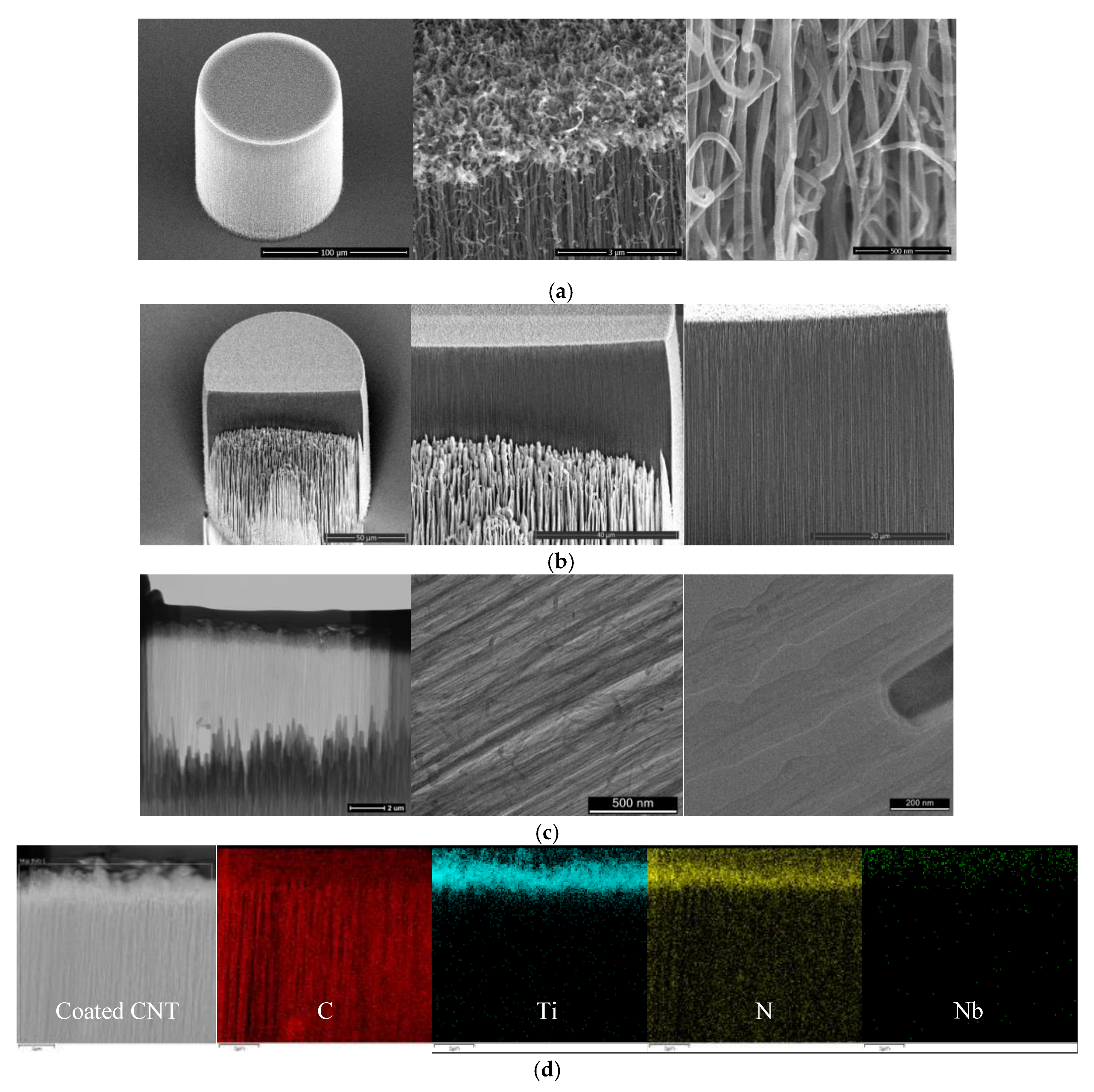
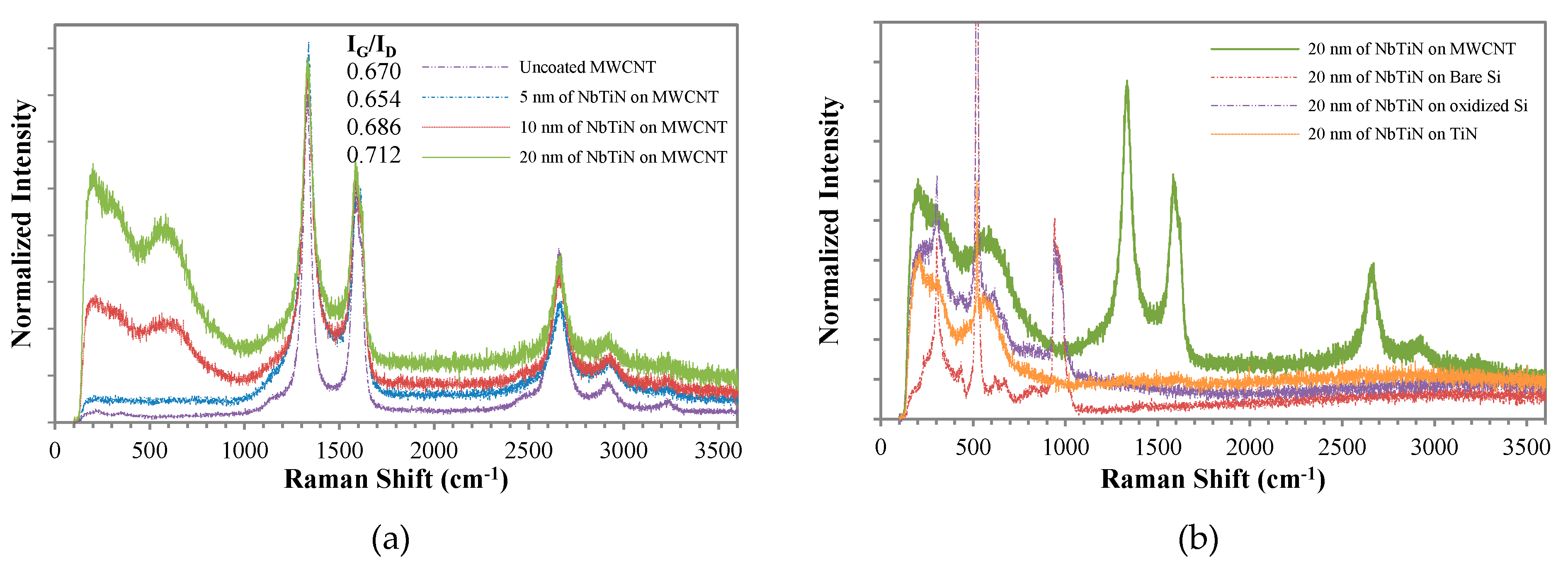
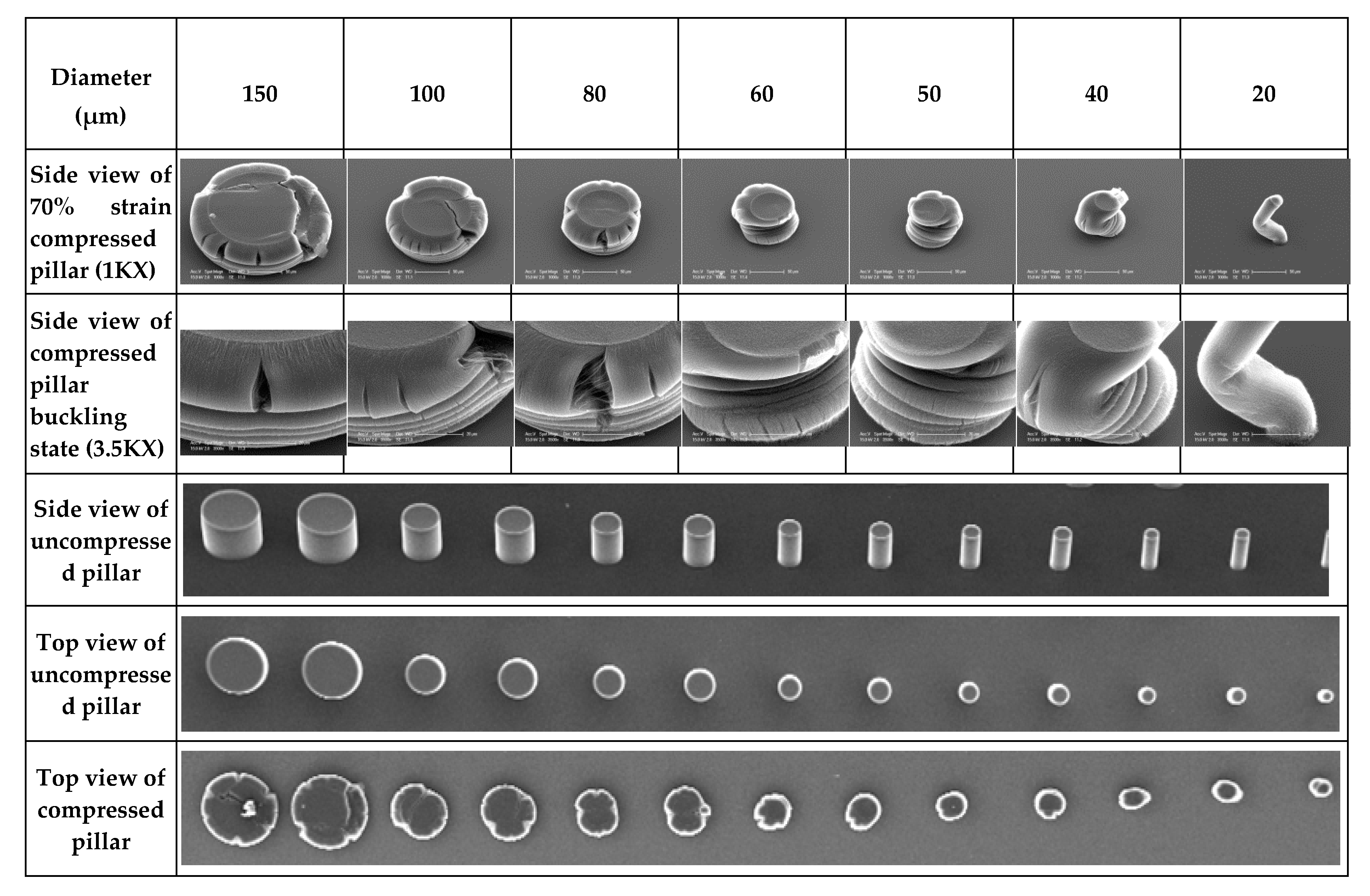
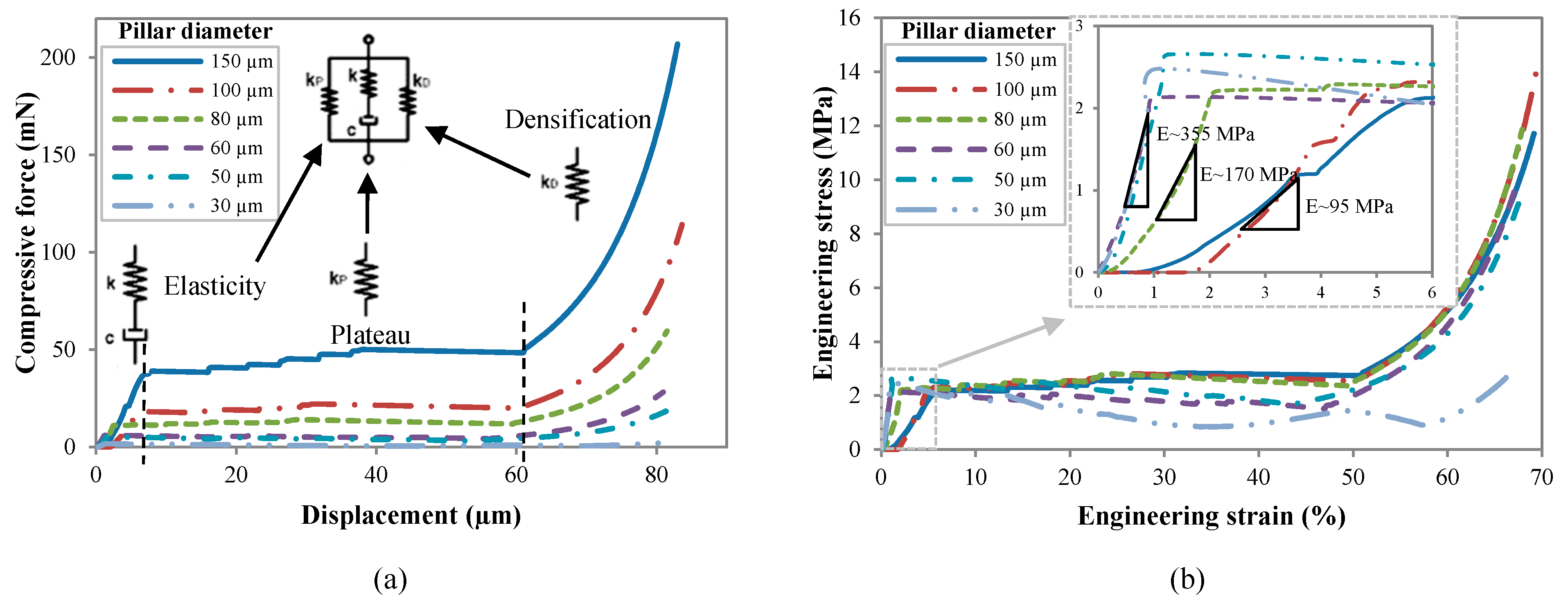
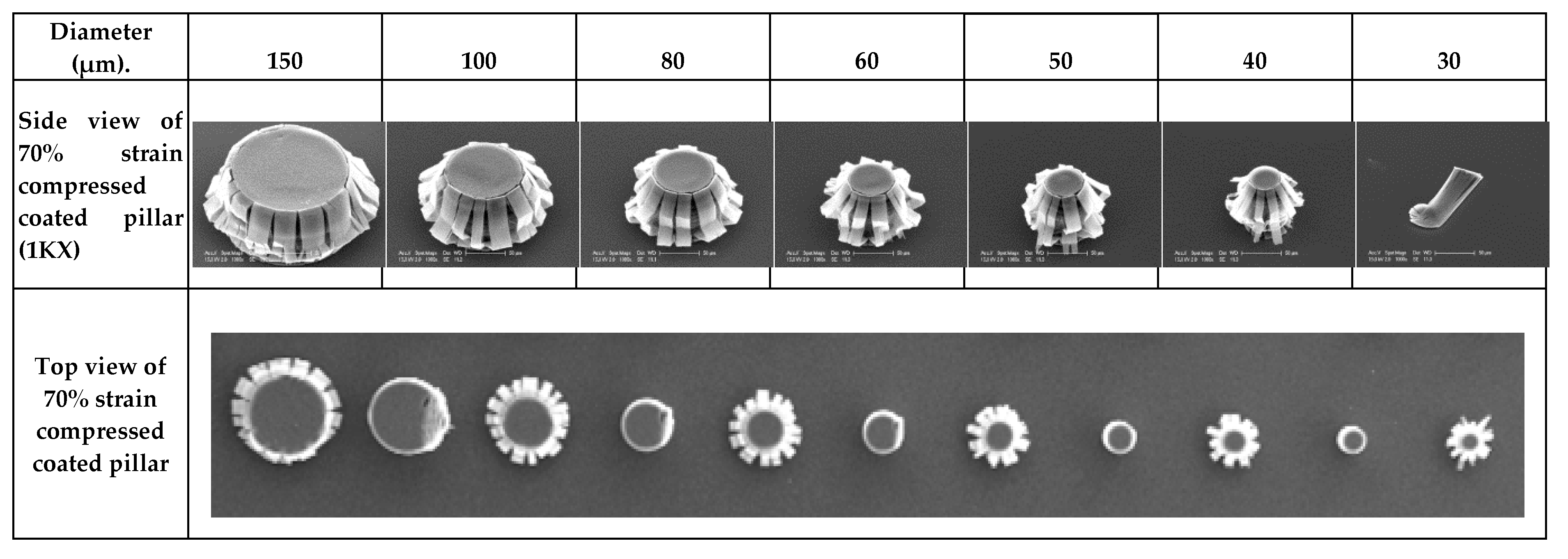

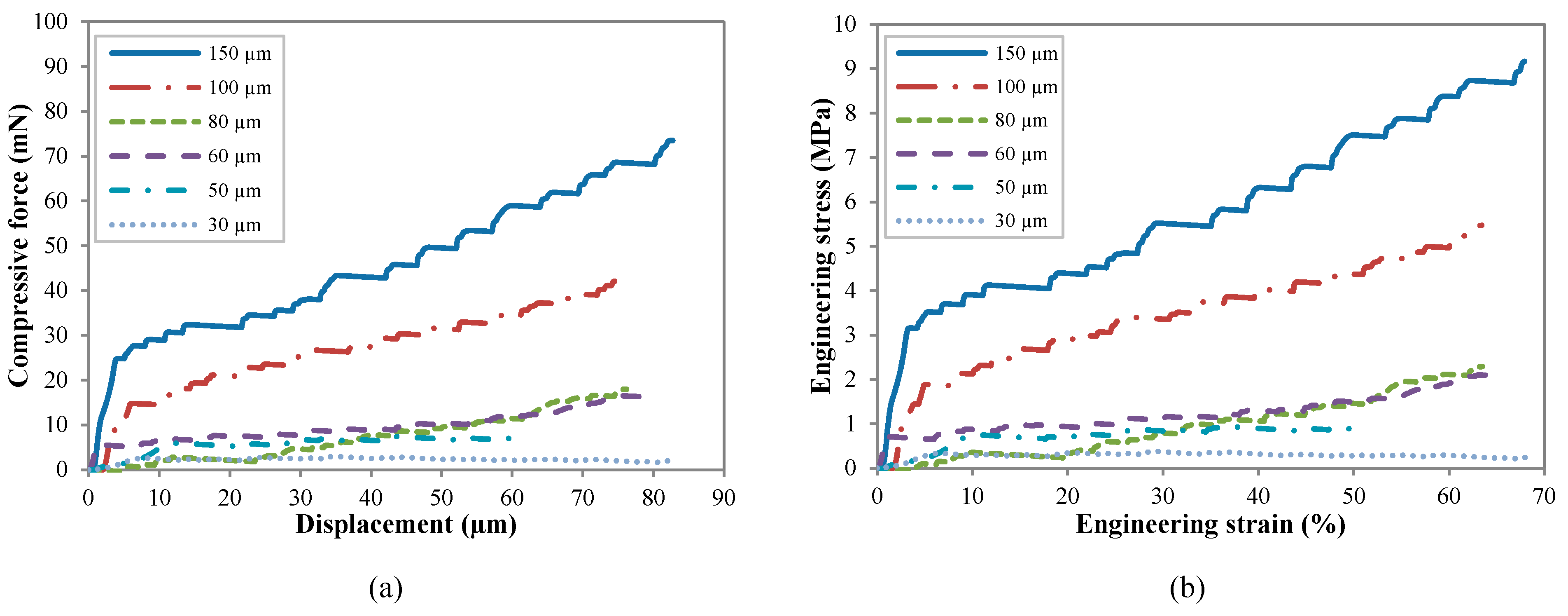


| Pillar Diameter [µm] | K [MPa] | C [MPa·Sec] | T = C/K [Sec] | kP [MPa] | γ [MPa] | n |
|---|---|---|---|---|---|---|
| 150 | 43 ± 0.5 | 215 ± 5 | 5.0 ± 0.2 | 1.8 ± 0.1 | 13.1 ± 0.1 | 8 |
| 100 | 30 ± 1 | 226 ± 12 | 7.5 ± 0.6 | 2.2 ± 0.2 | 16.0 ± 0.1 | 10 |
| 80 | 108 ± 3 | 270 ± 3 | 2.5 ± 0.1 | −1.30 ± 0.07 | 17.5 ± 0.5 | 6 |
| 60 | 307 ± 18 | 209 ± 3 | 0.70 ± 0.05 | −1.10 ± 0.06 | 16.5 ± 0.1 | 6 |
| 50 | 270 ± 11 | 185 ± 6 | 0.70 ± 0.05 | −1.90 ± 0.06 | 14.0 ± 0.6 | 6 |
| 30 | 344 ± 50 | 212 ± 4 | 0.6 ± 0.1 | −3.00 ± 0.15 | 4.4 ± 0.2 | 4 |
© 2020 by the authors. Licensee MDPI, Basel, Switzerland. This article is an open access article distributed under the terms and conditions of the Creative Commons Attribution (CC BY) license (http://creativecommons.org/licenses/by/4.0/).
Share and Cite
Mirza Gheitaghy, A.; Poelma, R.H.; Sacco, L.; Vollebregt, S.; Zhang, G.Q. Vertically-Aligned Multi-Walled Carbon Nano Tube Pillars with Various Diameters under Compression: Pristine and NbTiN Coated. Nanomaterials 2020, 10, 1189. https://doi.org/10.3390/nano10061189
Mirza Gheitaghy A, Poelma RH, Sacco L, Vollebregt S, Zhang GQ. Vertically-Aligned Multi-Walled Carbon Nano Tube Pillars with Various Diameters under Compression: Pristine and NbTiN Coated. Nanomaterials. 2020; 10(6):1189. https://doi.org/10.3390/nano10061189
Chicago/Turabian StyleMirza Gheitaghy, Amir, René H. Poelma, Leandro Sacco, Sten Vollebregt, and Guo Qi Zhang. 2020. "Vertically-Aligned Multi-Walled Carbon Nano Tube Pillars with Various Diameters under Compression: Pristine and NbTiN Coated" Nanomaterials 10, no. 6: 1189. https://doi.org/10.3390/nano10061189
APA StyleMirza Gheitaghy, A., Poelma, R. H., Sacco, L., Vollebregt, S., & Zhang, G. Q. (2020). Vertically-Aligned Multi-Walled Carbon Nano Tube Pillars with Various Diameters under Compression: Pristine and NbTiN Coated. Nanomaterials, 10(6), 1189. https://doi.org/10.3390/nano10061189







